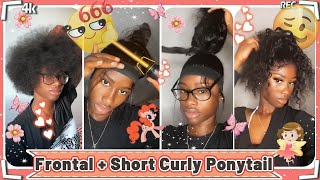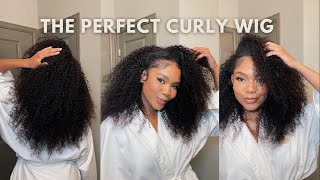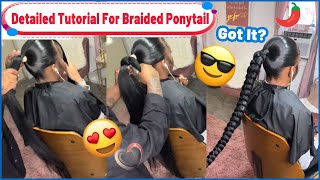Curly Hair Care Guide: How to Take Care of Your Naturally Curly Hair
Taking care of naturally curly or textured hair can be challenging. Our hair’s natural oils have to travel down all our bends and curves, making it more difficult to keep curly hair moisturized than straight hair. However, with the right washing, conditioning and styling tips, your curly hair can flourish.
How to Take Care of Naturally Curly Hair
Natural curly hair can become an asset if you know the proper way to maintain it. Take care of your curly hair by following the below tips & you’ll surely see the result.
Cleansing

When washing natural hair, it’s important that you use cleaning products that don’t dry out your hair or strip it off too much of its natural oils. These oils act as a natural conditioner for curly hair, so it’s important that you keep as much of it in your strands as possible.
The most popular hair cleanser out there is shampoo, which can be very drying because of the sulfates it contains. However, curly-haired girls are lucky to have the option of sulfate-free shampoos, which are sold by many brands like Shea Moisture, ORS and Sofn’free. These shampoos are much gentler on natural hair and don’t strip it like their sulfate-containing counterparts.

Also highly popular and effective at gently cleansing curly hair for women are co-washes. A co-wash is a conditioner wash that provides softness and moisture to hair while providing cleaning properties. Many curly girls use regular rinse-out conditioners to co-wash, but many brands have formulated real co-washes that contain Cocamidopropyl betaine, a gentle cleanser that works extremely well and isn’t always found in most regular rinse-out conditioners.

For more natural methods of washing hair, clay or mud washes are extremely popular for those who prefer to stay away from chemicals and commercial products altogether. These washes clean without stripping, detoxify and soothe natural hair and also provide soothing properties to the scalp, an important factor in hair growth and hair care. Bentonite, rhassoul and kaolin clay are the 3 popular clays that many girls with naturally curly hair have turned to.
Read these posts:
- The Most Popular Short Curly Bob Cuts
- Short Curly Haircuts for Black Women
- Curly Ombre Hairstyle Ideas
In the world of herbs, there are many options in terms of cleansers when it comes to taking care of your curly hair. Aritha and shikakai are two Indian herbs that have cleansing and softening properties. Though they originated in India and grew to popularity there, their use has expanded worldwide. They are extremely popular in the Caribbean islands, such as Trinidad and Tobago, which has a large East Indian population and influence.
Short Curly Haircuts & Hairstyles
Conditioning
Equally important as washing is conditioning. Conditioning can be seen as having two parts: normal conditioning and deep conditioning. Normal conditioning should be done after every shampoo, even if a sulfate-free shampoo was used. It is done with a rinse-out conditioner – it is left on for 5-10 minutes and rinsed off immediately. These rinse-out conditioners provide softening properties to hair, but can be formulated for moisture needs or protein needs, both of which are equally important – we’ll see why in a moment.

Deep conditioning, on the other hand, is a penetrating treatment that serves to hydrate hair on a deeper level. It can come in the form of products marketed as deep conditioners, masks or treatments, and can also be formulated for moisture or protein needs. Deep conditioners are left on longer, from 15 minutes to an hour. They can be done before normal conditioning or after – it depends on what works for your own hair.
Maintaining the Moisture and Protein Balance

Moisture and protein balance is crucial to having healthy natural hair. It’s no secret that curly hair needs moisture, but protein is equally important. Protein keeps hair strong and resilient, and also helps hair to hold moisture. Too little protein results in weak, fragile hair that breaks easily, but you should beware. Too much protein causes hair to become hair, wiry and coarse, causing it to break easily as well. Learning how to balance protein with moisture can be a challenge, but a good rule of thumb is to look at how your hair acts and feels.
Is it stiff and dry no matter how much you moisturize it? Do moisture treatments bi-weekly and see if it changes. Is it limp and weak? Do a light protein treatment and see how it responds. Protein treatments, even light ones, aren’t needed every week, or even every month. When adsorbed to the hair, protein lasts longer than moisture, so whereas you should moisture deep condition every week, you’ll only need to do a protein deep condition every 2 to 4 months.
Recommended Posts:
- Curly Weave
- Curly Mohawk
Styling natural hair

Take care of your curly natural hair never means you can’t style. Whether your hair texture is curly, coiled or kinky, you have a wide range of styling options for any length of hair. Shorter hair that’s above neck length may be able to mainly do wash and go’s, finger coils and coil-outs, but hair past shoulder length can be styled using the above styles as well as buns, twist outs, ponytails, puffs, and much more.
Over-styling your hair may compromise its health, giving it split ends and weakening it, so from time to time you may want to employ low-manipulation or protective styles to give your hair a rest from all the manipulation that styling brings. Low-manipulation styles are styles that allow you to style your hair and then leave it untouched for days or even a week or a few weeks. These include twists, wash and go’s, buns, braided crowns and cornrows.

Protective styles are styles that you install to protect your hair. Common protective styles are crochet braids, braid extensions, weaves, wigs, faux locks and tucked styles that may hide your ends away, keeping them safe from wear.
As a natural, you also have the blessing of versatility, as you can flat iron your curly hair to make it straight. However, flat ironing should be done in moderation of heat as well as to maintain a healthy head of curly hair.
Trimming

Trimming is an important part of keeping your naturally curly hair healthy and flourishing. Due to manipulation, flat ironing or wear, the ends of your hair may become frayed or gain split ends. Tiny knots at the end of your hair’s individual strands called ‘single strand knots’ can also cause the ends of your hair to feel rough or cause them to tangle with other strands. This damage can cause tangling and knotting with other healthy parts of your hair, and can even make hair more difficult to detangle, style and comb. To remove this damage or prevent in the first place, trimming comes in extremely handy to keep your hair ends healthy.
There’s no set rule for trimming, but a good guide to go by is trimming from ¼ of an inch to ½ an inch every six months. If you constantly flat iron or manipulate your hair, this will be more often. The more you protect your hair, the less often and the less hair you’ll have to trim.
Another useful tip for trimming is to use the ‘search and destroy’ method. This method doesn’t require that you give all your hair’s ends a general trim, but that you seek out the areas that have split ends, single strands knots or other forms of damage and trim them off. If you want to retain more length and preserve your hair, this method may be best, but it also requires a lot of time.
After a trim, it’s important that you protect your freshly cut ends in order to avoid a repeat of damage and another trim that may be prevented by good styling choices.
You may like:
- Curly Bob Haircuts
- Sew-In Bobs
Avoiding damage to your curly hair
The most important reason for curly hair care is to prevent it from damaging. Aside from manipulation and wear, hair can also be damaged by other common styling practices and processes like pulling hair too tightly, coloring and one of the previously mentioned culprits, flat ironing.
When you pull your hair too tightly in styles like ponytails, puffs and buns, you can pull out the hair around your edges and nape. This not only causes temporary thinning that may be difficult to regrow but can result in traction alopecia, which is a permanent damaging of the hair follicles due to scarring. With traction alopecia, lost hair will not grow back.

Coloring is a process that is extremely tempting. The appeal of a red, purple or blue man may be all too exciting, but coloring comes at a price. Certain coloring methods like dark rinses don’t necessarily damage hair, but semi-permanent and permanent hair colors require bleaching, which strips the hair of its natural pigments to provide a blank canvas for new colors to be more vibrant.
Unfortunately, bleaching also alters hair’s structure and can cause it to be dry, brittle and limp. For naturally curly hair, this means that your curls or kinks may become wavy or straight permanently. Taking care of bleached hair requires up to 3 times the amount of care required for virgin hair, which results in time, money and attention that you may not be able to give.
To avoid being in such a situation, look for healthy or temporary hair color options that don’t require bleaching and don’t damage your hair. Hair color sprays, pigmented eyeshadows are great choices if you want a full, vibrant color that you can wash out, and henna is perfect for giving your hair natural reddish tints that last.

Flat ironing is a favorite for natural girls who like to switch it up, and there’s nothing wrong with heat use. However, improper or incorrect heat use can damage your hair severely, leaving your curls limp or even straight. To avoid heat damage, limit how often you flat iron your hair and how high of a temperature you use.
Other useful tips for healthy and safe flat ironing include doing it on clean, dry hair, making few passes with your flat iron and using a good heat protectant. Heat protectants are absolutely necessary to flat iron hair safely, as the silicones that they contain provide a barrier between your hair strands and the heat from your iron.
Brands like Fantasia IC and Tresemme are known for their heat protectants, so either of these may be a good choice for you to try.
By staying away from practices that cause damage to your hair, you can maintain your curly mane and keep it moisturized, shiny and glowing.
Tantalizing Short Curly Bobs That’ll Make You Look Smarter
Curly hair may require a lot of care, but if you’re a natural who is longing to get her hair into the best shape and length it has ever been, then that care is definitely worth it in the long run. By using these tips on washing, conditioning, protein, styling and avoiding damage, you can transform your hair from dry and unmanageable to thick, healthy and lustrous in only a matter of time.




